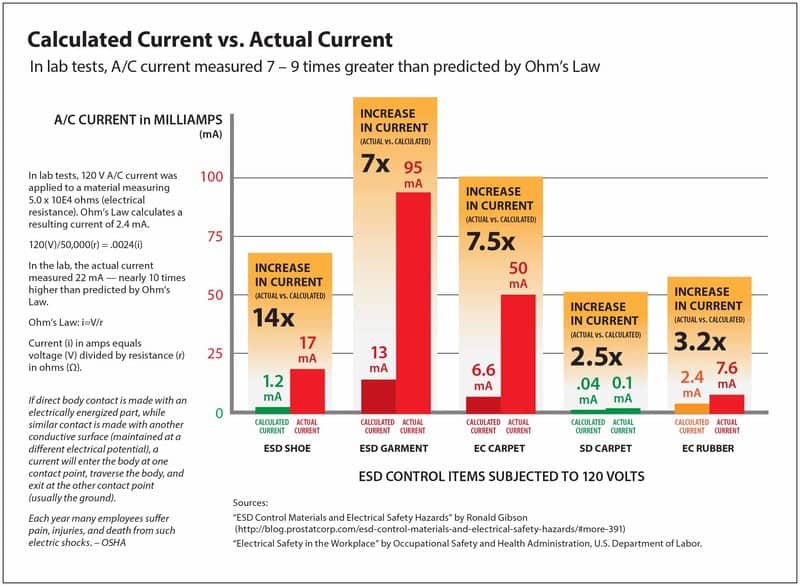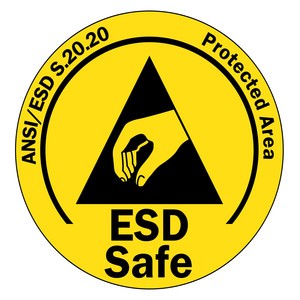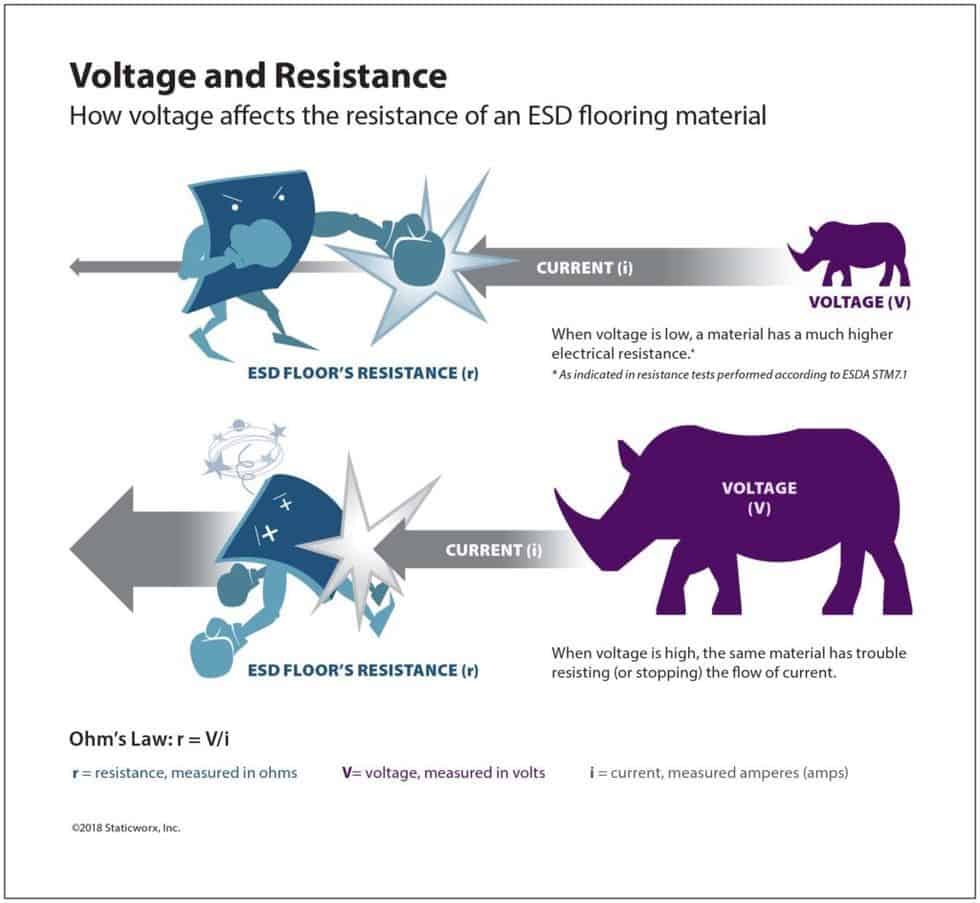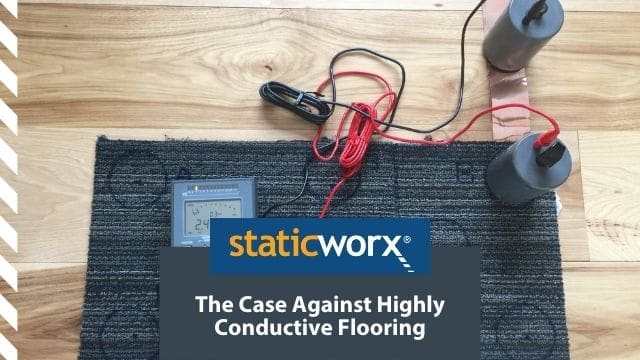
The Case Against Highly Conductive ESD Flooring
NFPA 99 No Longer Covers Conductive Flooring
[11 min read, 4 min videos]

You may have heard ESD flooring manufacturers refer to a standard called NFPA 99. With roots dating back to the 1950s, NFPA 99 guides health care services in minimizing the hazards of fire, explosion, and electricity in their facilities.
In 2015, the NFPA removed conductive flooring from the standard. But let’s forget for a moment that, for ESD flooring, NFPA 99 is defunct.

Neither test reliably simulates a real-world environment: Both use a battery-operated generator to apply voltage across the surface of the flooring material. Battery-operated generators put out direct, or D-C, current, which flows in one direction. The electricity in common power circuits travels in waves, or A-C, alternating current, which periodically changes or reverses direction.
An independent engineering lab tested the resistance of ESD floors using both A-C and D-C currents. Delivered across an ESD floor, A-C currents measured as much as nine times higher than predicted by theoretical calculations based on Ohm’s Law.
You may have heard ESD flooring manufacturers refer to a standard called NFPA 99. With roots dating back to the 1950s, NFPA 99 guides health care services in minimizing the hazards of fire, explosion, and electricity in their facilities.
In 2015, the NFPA removed conductive flooring from the standard. But let’s forget for a moment that, for ESD flooring, NFPA 99 is defunct.

Neither test reliably simulates a real-world environment: Both use a battery-operated generator to apply voltage across the surface of the flooring material. Battery-operated generators put out direct, or D-C, current, which flows in one direction. The electricity in common power circuits travels in waves, or A-C, alternating current, which periodically changes or reverses direction.
An independent engineering lab tested the resistance of ESD floors using both A-C and D-C currents. Delivered across an ESD floor, A-C currents measured as much as nine times higher than predicted by theoretical calculations based on Ohm’s Law.



It’s also why the FAA (in FAA 019f) prohibits conductive flooring that measures under 1 x 10E6—anyplace where personnel may come into contact with energized equipment. In layman’s terms: anywhere electronics are plugged into an outlet.
This means, in a real-world environment, electricity will flow across the floor far faster than predicted mathematically. That’s why, when selecting any ESD floor, it’s crucial to consider safety.
It’s also why the FAA (in FAA 019f) prohibits conductive flooring that measures under 1 x 10E6—anyplace where personnel may come into contact with energized equipment. In layman’s terms: anywhere electronics are plugged into an outlet.
Resistance Testing: NFPA 99 and ANSI/ESD 7.1
While NFPA 99 and ANSI/ESD 7.1 were similar tests, they differed in one very important way: The test for NFPA 99 was done with 500 volts of electricity. ESD 7.1 is done with only 10 volts. 10. That’s 1 fiftieth the voltage used in NFPA 99.
Why does it matter?
Because some people assume the readings are interchangeable—and they’re not. According to Ohm’s Law, voltage correlates inversely to electrical resistance. Put simply: less applied voltage yields a higher resistance reading. And vice versa.


The NFPA considers a resistance of 25,000 ohms (2.5 x 10E4) safe—if the floor is tested at 500 volts. Tested at 10 volts, the same floor would likely measure over 1 x 10E5, or 100,000 ohms. Both resistance measurements are considered safe for applications where energized equipment is in use—based on their test methods.
Now, consider the reverse: more applied voltage yields lower resistance readings.
Suppose, at 10 volts, per ESD 7.1, a floor measures 25,000 ohms. At 500 volts, the same floor could measure as low as 2500 ohms—a resistance so dangerously low that electricity would rocket across its surface, at a rate lethal to humans.
If someone standing or kneeling on an overly conductive floor were to accidentally become part of a live electrical circuit—while servicing or inspecting electrified equipment, for example—he or she could receive a dangerous electrical shock.


If a manufacturer claims their highly conductive floor meets the defunct NFPA 99 standard, be sure to ask how the floor was tested and exactly how much voltage was applied.
To be sure your floor falls within a safe resistance range:
- prefer suppliers that don’t sell overly conductive floors;
- request independent lab testing;
- specify products with an inherent resistance buffer that’s at least one order of magnitude higher than the minimum, 25,000 ohms (10E5 rather than 10E4).
Neither NFPA 99 or ANSI/ESD STM7.1 should be used as the sole basis for safety judgments.
✓ visual selector guide;
✓ walking body voltage/low static generation;
✓ resistance requirements and testing;
✓ ESD flooring comparison;
✓ industry standards & test methods;
✓ key ESD terms
Ohm's Law and Calculated Current
In a recent white paper, Ronald Gibson, a retired ESD program manager from Celestica Corporation, pointed out that measurements from D-C resistance meters should never be used to determine if a grounded floor is safe or unsafe. Gibson provided examples demonstrating that actual (as opposed to calculated) A-C electrical currents can be much higher than one would predict by calculating current using ohm meter readings and inserting them into an Ohm’s Law equation.
In Gibson’s example below, the true A-C current (22 milliamps) is actually nine times greater than the calculated current of 2.4 milliamps.
| Item | Condition | Voltage | Current | Resistance |
|---|---|---|---|---|
| Conductive Scrim inside Table Covering | Current limited Resistance Meter Reading | 10 | 200 uA | 5.0 x 10E4 |
| Calculated current based on Ohm’s Law | 120 | 2.4 milliamps | 5.0 x 10E4 | |
| Actual AC current | 120 | 22 milliamps | 5.4 x 10E3 | |
| Increase in current | Actual current 9 times higher than predicted |
Based on Gibson’s comments we sought the services of an electrical engineering lab to subject conductive and static-dissipative carpet tiles to this same type of scrutiny. The lab’s findings concurred with the data Gibson provided in his paper on electrical safety. As predicted, static-dissipative flooring allowed far less current than conductive flooring.
In these tests, the amount of current delivered through a conductive carpet tile was measured above 50 milliamps. OSHA cites 16 milliamps as the level of current where a person’s muscles would contract and prevent them from letting go of the electrified object.
The A-C current measured across conductive carpet tile was over three times that amount: 50 milliamps is considered a “fatal current.” Since studies have shown that conductive carpet offers no performance advantage over static dissipative carpet, there is no incentive for its use.
Caveat: Electrical Safety Testing
Testing to prove an electrically safe working environment in a room equipped with conductive flooring is not the same as performing a simple set of resistance tests with a current limiting ohm meter. Definitively stating that an environment is “electrically safe” requires special licensing, extensive research and the testing would need to be performed after the flooring has been installed.
To be conclusive, this level of safety testing would need to capture A-C leakage current measurements under conditions simulating an A-C short circuit, similar to the way electrical high voltage safety shoes are tested.
-
Static Conductive
Materials -
ESD Control Flooring
and Floor Coverings -
Carpeting and Floor
Tiles Resistance - Additional Links
Those materials with a surface resistivity less than 1.0 x 10E5 ohms per square when tested per ANSI/ESD STM11.11 shall be considered conductive. Conductive ESD control materials shall not be used for ESD control work surfaces, tabletop mats, floor mats, flooring, or carpeting where the risk of personnel contact with energized electrical or electronic equipment exists.
ESD control floors and floor coverings shall have a point-to-point resistance and a surface-to ground resistance of greater than 1.0 x 10E6 ohms and less than 1.0 x 10E9 ohms (ANSI/ESD STM7.1). ESD control flooring, floor coverings, and floor tile laminates include materials such as vinyl tile, vinyl sheet, carpet, carpet tile, and carpet tile with positioning buttons, but not the applied coatings on the material.
Any carpeting or floor tiles should have a resistance to ground between 10E6 and 10E10 ohms when measured using the method of ESD-S7.1. Existing flooring that does not meet this requirement should be treated with a topical antistatic solution such as an antistatic floor wax. The effectiveness of antistatic solutions is temporary and varies with floor material and relative humidity. Flooring resistance should be monitored every two weeks minimum to verify conformance to the above requirement.
ATIS 0600321 concur with these government standards. From 2015 version of ATIS: 4.2 Flooring.
Get in Touch
The form below will help us better understand your needs and get you as quickly as possible to the right person. We look forward to helping you solve your static problem!
You can expect a response within 24 hours. For faster service, please give us a call: 617-923-2000
"*" indicates required fields
Visit our privacy policy to find out how we process data.
Learning Center Articles
- ESD Basics
- Installation & Maintenance
- Selecting & Specifying an ESD Floor
- Technical Information
- 7 Common Mistakes Selecting an ESD floor
- A Guide to ESD Flooring Selection
- Avoid Costly Failures: What You Need to Know When Specifying ESD Flooring
- Choosing ESD Flooring for:
- ESD Footwear: What Is It and When Is It Necessary?
- ESD Footwear for Electronics Manufacturing and Handling Applications
- Facility Managers’ Guide to Selecting ESD Flooring
- The Need for Due Diligence in Specifying Static-Free Flooring
- Standard of Care for Specifying Floors in Mission-Critical Spaces
- Understanding the Hidden Costs of ESD Flooring

StaticWorx high-performance static-control floors protect electronic components, explosives, and high-speed computers from damage caused by static electricity. ESD flooring is part of a system. Choices should always be based on objective, researched evidence. When you partner with us, we look at all possible items that may need to integrate with the floor, and, focusing on your goals and objectives, help you find the right floor for your application.










